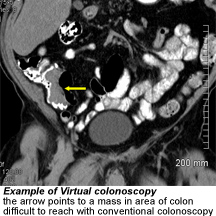Virtual colonoscopy (VC) is an examination of the large intestine and rectum involving a CT scan after the introduction of gas into the colon. Another name for the procedure is CT colonography.
 The primary objective of the exam is to screen for abnormalities of the large bowel including polyps or cancer.
The primary objective of the exam is to screen for abnormalities of the large bowel including polyps or cancer.
Why have a VC?
Colorectal cancer is the second most common cause of cancer related deaths in the U.S. after lung cancer. Finding and removing colon polyps before they can become cancerous can reduce the incidence of colon cancer dramatically. Current recommendations for colon screening include a routine colonoscopy every 10 years beginning at age 50, with earlier and or more frequent screening in other situations such as family history of colorectal cancer and certain types of polyps. Virtual colonoscopy every 5 years is a good alternative for colon screening.
Process
Both conventional and virtual colonoscopies require you to take a laxative or other agent to make sure that the colon is free of stool during the examination. This is necessary to increase the accuracy for detecting abnormalities. Unlike conventional colonoscopy, Virtual Colonoscopy requires no intravenous sedation during the procedure. This allows the patient to swiftly return to usual activities immediately after the procedure with little “post op” recovery.
Cost
The cost of virtual colonoscopy is half that of a conventional colonoscopy. There are “virtually” no complications associated with a virtual colonoscopy. Conventional colonoscopy is also a very safe procedure, but does have some potential complications, including risks associated with sedation and the remote chance of bowel perforation. It can be difficult to evaluate the entire bowel with conventional colonoscopy, not so with VC.
Advantages and Disadvantages
VC is better tolerated than conventional colonoscopy, with less discomfort. The entire abdomen and pelvis are imaged with CT, not just the bowel lining. This may help detect unsuspected lesions. Disadvantages of VC include radiation exposure and some limitation in identifying polyps less than 1 cm in size. However, polyps less than 1cm are usually insignificant. Another disadvantage of VC is that it is a purely diagnostic study. If a significant polyp is found, it will need to be removed by conventional colonoscopy or through surgery. The flip side of the argument is that VC can certainly eliminate unnecessary colonoscopies, the discomfort of traditional colonoscopy procedures and reduce overall health care expenses.
Additional Resources
For more information you may want to go to the following websites: www.nih.gov (National Institutes of Health); www.nci.gov (National Cancer Institute); www.rsna.org (Radiology Association of North America), to name a few.



